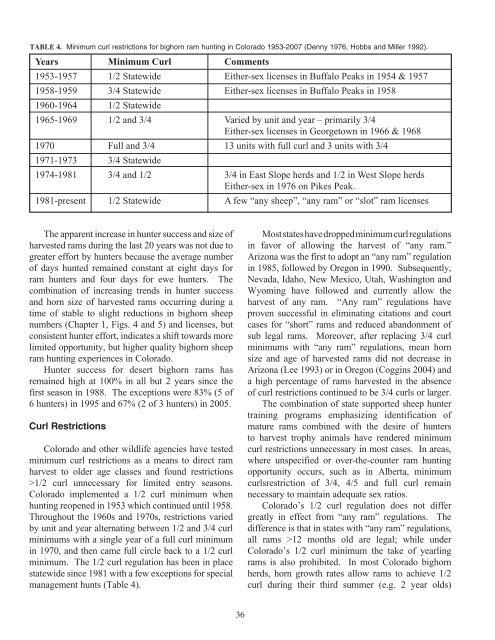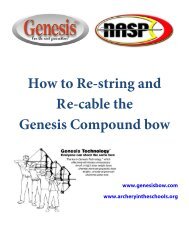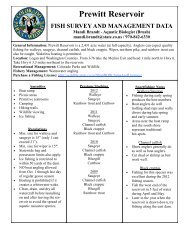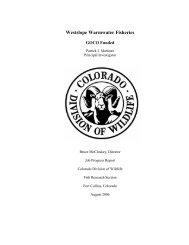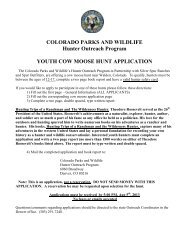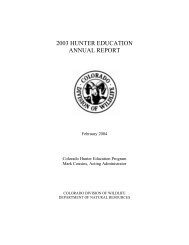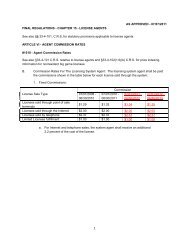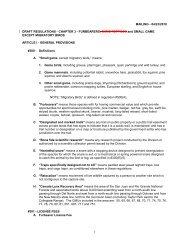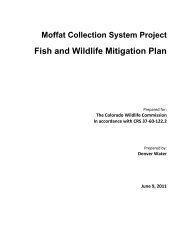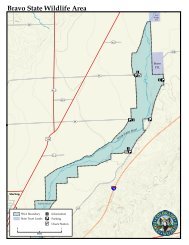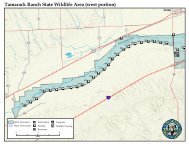COLORADO BIGHORN SHEEP MANAGEMENT PLAN 2009−2019
COLORADO BIGHORN SHEEP MANAGEMENT PLAN 2009−2019
COLORADO BIGHORN SHEEP MANAGEMENT PLAN 2009−2019
You also want an ePaper? Increase the reach of your titles
YUMPU automatically turns print PDFs into web optimized ePapers that Google loves.
TABLE 4. Minimum curl restrictions for bighorn ram hunting in Colorado 1953-2007 (Denny 1976, Hobbs and Miller 1992).<br />
Years Minimum Curl Comments<br />
1953-1957 1/2 Statewide Either-sex licenses in Buffalo Peaks in 1954 & 1957<br />
1958-1959 3/4 Statewide Either-sex licenses in Buffalo Peaks in 1958<br />
1960-1964 1/2 Statewide<br />
1965-1969 1/2 and 3/4 Varied by unit and year – primarily 3/4<br />
Either-sex licenses in Georgetown in 1966 & 1968<br />
1970 Full and 3/4 13 units with full curl and 3 units with 3/4<br />
1971-1973 3/4 Statewide<br />
1974-1981 3/4 and 1/2 3/4 in East Slope herds and 1/2 in West Slope herds<br />
Either-sex in 1976 on Pikes Peak.<br />
1981-present 1/2 Statewide A few “any sheep”, “any ram” or “slot” ram licenses<br />
The apparent increase in hunter success and size of<br />
harvested rams during the last 20 years was not due to<br />
greater effort by hunters because the average number<br />
of days hunted remained constant at eight days for<br />
ram hunters and four days for ewe hunters. The<br />
combination of increasing trends in hunter success<br />
and horn size of harvested rams occurring during a<br />
time of stable to slight reductions in bighorn sheep<br />
numbers (Chapter 1, Figs. 4 and 5) and licenses, but<br />
consistent hunter effort, indicates a shift towards more<br />
limited opportunity, but higher quality bighorn sheep<br />
ram hunting experiences in Colorado.<br />
Hunter success for desert bighorn rams has<br />
remained high at 100% in all but 2 years since the<br />
first season in 1988. The exceptions were 83% (5 of<br />
6 hunters) in 1995 and 67% (2 of 3 hunters) in 2005.<br />
Curl Restrictions<br />
Colorado and other wildlife agencies have tested<br />
minimum curl restrictions as a means to direct ram<br />
harvest to older age classes and found restrictions<br />
>1/2 curl unnecessary for limited entry seasons.<br />
Colorado implemented a 1/2 curl minimum when<br />
hunting reopened in 1953 which continued until 1958.<br />
Throughout the 1960s and 1970s, restrictions varied<br />
by unit and year alternating between 1/2 and 3/4 curl<br />
minimums with a single year of a full curl minimum<br />
in 1970, and then came full circle back to a 1/2 curl<br />
minimum. The 1/2 curl regulation has been in place<br />
statewide since 1981 with a few exceptions for special<br />
management hunts (Table 4).<br />
36<br />
Most states have dropped minimum curl regulations<br />
in favor of allowing the harvest of “any ram.”<br />
Arizona was the first to adopt an “any ram” regulation<br />
in 1985, followed by Oregon in 1990. Subsequently,<br />
Nevada, Idaho, New Mexico, Utah, Washington and<br />
Wyoming have followed and currently allow the<br />
harvest of any ram. “Any ram” regulations have<br />
proven successful in eliminating citations and court<br />
cases for “short” rams and reduced abandonment of<br />
sub legal rams. Moreover, after replacing 3/4 curl<br />
minimums with “any ram” regulations, mean horn<br />
size and age of harvested rams did not decrease in<br />
Arizona (Lee 1993) or in Oregon (Coggins 2004) and<br />
a high percentage of rams harvested in the absence<br />
of curl restrictions continued to be 3/4 curls or larger.<br />
The combination of state supported sheep hunter<br />
training programs emphasizing identification of<br />
mature rams combined with the desire of hunters<br />
to harvest trophy animals have rendered minimum<br />
curl restrictions unnecessary in most cases. In areas,<br />
where unspecified or over-the-counter ram hunting<br />
opportunity occurs, such as in Alberta, minimum<br />
curlsrestriction of 3/4, 4/5 and full curl remain<br />
necessary to maintain adequate sex ratios.<br />
Colorado’s 1/2 curl regulation does not differ<br />
greatly in effect from “any ram” regulations. The<br />
difference is that in states with “any ram” regulations,<br />
all rams >12 months old are legal; while under<br />
Colorado’s 1/2 curl minimum the take of yearling<br />
rams is also prohibited. In most Colorado bighorn<br />
herds, horn growth rates allow rams to achieve 1/2<br />
curl during their third summer (e.g. 2 year olds)


